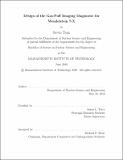| dc.contributor.advisor | James L. Terry. | en_US |
| dc.contributor.author | Tang, Kevin(Nuclear science engineer)Massachusetts Institute of Technology. | en_US |
| dc.contributor.other | Massachusetts Institute of Technology. Department of Nuclear Science and Engineering. | en_US |
| dc.date.accessioned | 2020-01-08T19:34:18Z | |
| dc.date.available | 2020-01-08T19:34:18Z | |
| dc.date.copyright | 2019 | en_US |
| dc.date.issued | 2019 | en_US |
| dc.identifier.uri | https://hdl.handle.net/1721.1/123364 | |
| dc.description | This electronic version was submitted by the student author. The certified thesis is available in the Institute Archives and Special Collections. | en_US |
| dc.description | Thesis: S.B., Massachusetts Institute of Technology, Department of Nuclear Science and Engineering, 2019 | en_US |
| dc.description | Cataloged from PDF version of thesis. | en_US |
| dc.description | Includes bibliographical references (page 97). | en_US |
| dc.description.abstract | Stellarators, being not as well-studied as tokamaks, have plenty of interesting physics to examine, as investigations of stellarators as a viable configuration for future power plants continue. One of these aspects is boundary turbulence in the plasma, as the magnetic configuration in stellarators is different from that in tokamaks and thus provides different plasma behavior. To study this turbulence, we are designing a "gas-puff imaging" diagnostic to install onto the Max Planck Institute of Plasma Physics's Wendelstein 7-X (W7-X), which is currently the world's most advanced and largest stellarator. This diagnostic employs a fast-camera to observe a localized puff of gas as it interacts with the boundary plasma near the last closed flux surface of the plasma. The diagnostic consists of a fast-camera component, a light-collection component, a "gas-puff" component with valves to inject controlled amounts of gas, and a component for valve control and data collection purposes. This thesis documents some of the aspects of the design of the diagnostic and its components for W7-X. | en_US |
| dc.description.statementofresponsibility | by Kevin Tang. | en_US |
| dc.format.extent | 97 pages | en_US |
| dc.language.iso | eng | en_US |
| dc.publisher | Massachusetts Institute of Technology | en_US |
| dc.rights | MIT theses are protected by copyright. They may be viewed, downloaded, or printed from this source but further reproduction or distribution in any format is prohibited without written permission. | en_US |
| dc.rights.uri | http://dspace.mit.edu/handle/1721.1/7582 | en_US |
| dc.subject | Nuclear Science and Engineering. | en_US |
| dc.title | Design of the gas-puff imaging diagnostic for Wendelstein 7-X | en_US |
| dc.type | Thesis | en_US |
| dc.description.degree | S.B. | en_US |
| dc.contributor.department | Massachusetts Institute of Technology. Department of Nuclear Science and Engineering | en_US |
| dc.identifier.oclc | 1134768855 | en_US |
| dc.description.collection | S.B. Massachusetts Institute of Technology, Department of Nuclear Science and Engineering | en_US |
| dspace.imported | 2020-01-08T19:34:17Z | en_US |
| mit.thesis.degree | Bachelor | en_US |
| mit.thesis.department | NucEng | en_US |
